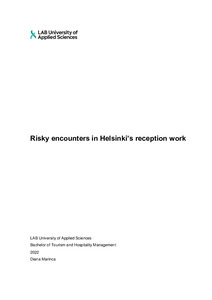Risky encounters in Helsinki’s reception work
Marinca, Diana (2022)
Marinca, Diana
2022
All rights reserved. This publication is copyrighted. You may download, display and print it for Your own personal use. Commercial use is prohibited.
Julkaisun pysyvä osoite on
https://urn.fi/URN:NBN:fi:amk-2022060114126
https://urn.fi/URN:NBN:fi:amk-2022060114126
Tiivistelmä
Receptionists in low-budget accommodation companies encounter dangerous situations at the hands of customers throughout the Helsinki area. Thus, the goal was to understand the types of abuse, harassment, and dangers that can occur among low-budget accommodation businesses. The main objectives were to find the consequences receptionists face when exposed to verbal abuse, physical abuse, and sexual harassment along with prevention measures against it.
A qualitative research approach was used in the form of interviews. In total, seven people working in four low-budget accommodation companies were chosen. A thematic content analysis style was used to identify common themes and patterns in the data; along with a narrative analysis style that highlighted important aspects in the gathered data.
The results revealed that several of the employees fit into an employee vulnerability criterion, which subsequently impacted their working life. There were multiple forms of consequences, from mental to physical. The mental ones were found to contribute to burnout, while the physical ones ranged from mild to severe injuries. Both could lead to a complete change of career for the affected receptionist. Prevention methods centred around hardware, de-escalation methods and the employers’ responsibilities.
A qualitative research approach was used in the form of interviews. In total, seven people working in four low-budget accommodation companies were chosen. A thematic content analysis style was used to identify common themes and patterns in the data; along with a narrative analysis style that highlighted important aspects in the gathered data.
The results revealed that several of the employees fit into an employee vulnerability criterion, which subsequently impacted their working life. There were multiple forms of consequences, from mental to physical. The mental ones were found to contribute to burnout, while the physical ones ranged from mild to severe injuries. Both could lead to a complete change of career for the affected receptionist. Prevention methods centred around hardware, de-escalation methods and the employers’ responsibilities.
